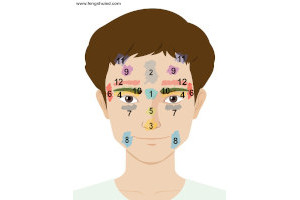When we talk about Chinese astrology, it is almost always about the concepts of bazi (八字) or zi wei dou shu (紫薇斗数).
The former is more widely recognizable as it is often referenced in TV shows, movies, magazines, and also more widely taught by masters of Chinese metaphysics.
However, one of the big reasons for zi wei dou shu (ZWDS) to enjoy lesser fanfare is that it is much more complex for new learners to quickly comprehend. The harder and longer it takes for a beginner to make sense of the subject, the more quickly he or she loses interest.
The depth and breadth of the study of ZWDS, or purple star astrology, can be so deep and wide that it was often said during ancient times that even career academics would take a lifetime (or maybe 2) to truly master the art. This is of course within the context of a much shorter life expectancy centuries ago.
The basic concept is that the emperor star, or king star, is the ziwei star which stays in it’s position in the night sky while other stars revolves around it. This central star is said to be a reference to Polaris.
So much variables are at play in ziwei that some masters have even claimed that bazi is a spinoff from it. This can be observed from evidence that various micro concepts of bazi appears to be mirror images of those in ZWDS. And since ZWDS has been practiced for hundreds of years before ZiPing (子平) wrote his infamous classic on bazi, it’s hard to argue against that claim.
Some even contend that other metaphysical works such as Qimen Dunjia also originated from ZWDS as the former has some variables that are eerily similar to the latter. But that is a topic for another day.
There is no general consensus that agree on evidence which indicate who exactly created ZWDS. However most would agree that the reiterate work of one Chen XiYi (陳希夷) was what turned the spotlight on the ancient metaphysical art.
The birth chart of Zi Wei Dou Shu
The gist of any astrology reading is in interpreting a birth chart.
A birth chart generated from ZWDS is based on the birth date and time according to the lunar calendar, and consist of 12 squares forming the outer layer of a 4×4 grid. Take note that a new day starts at 11pm. The central square made up of 2×2 smaller squares is empty and is used to note the important points such as the birth date of the individual being read.
Each of the 12 squares, which we will call palaces from now on, can consist of a variety of stars with no limit to how many can squeeze in.
The central figure is the Ming Gong (命宫) and the Shen Gong (身宫). They can be referred to as the life palace and body palace respectively. The former is linked to a person’s cosmic energy during conception and the latter is associated with after birth.
Each of the 12 palaces would contain a heavenly stem and earthly branch. With Zi rat at the second from the right at the row, and Yin tiger always starting from the bottom left palace. As there are 12 palaces to fill only 10 heavenly stems, there would always be 2 heavenly stems that repeat themselves on the natal chart.
There is a logic behind how each of these stars and palaces are plotted into a chart. But it is not the topic of discussion here.
When this base plate of variables are plotted into a chart, a set of 12 main palaces (十二宫) are then inserted. These stars can be calculated with formulas and numbers. But they can also be easily referenced with tables by using Ming Gong as the starting point.
The 12 palaces are namely:
- Ming gong 命宮
- Fu mu 父母
- Fu de 福德
- Tian zhai 田宅
- Shi ye 事業
- Jiao you 交友
- Qian yi 遷移
- Ji e 疾厄
- Cai bo 財帛
- Zi nu 子女
- Fu qi 夫妻
- Xiong di 兄弟
Each person would have big luck cycles that take up 10 years each, and small luck cycles that run 1 year each. How the sequence of luck cycles are determined is influenced by the person being born in what zodiac year, and what type of base element the birth chart has. The latter being determined by referencing the nayin concept of 5 elements flow.
For example, if Shen Gong is located in the 田宅宮, it can be deduced that the pursuit of property can become a theme of life. Especially after the age of 35 since the shen gong is associated with the later ages in life. If the luck pillar is favorable to this combination during a period after 35, then it would be the period where activities driven by this desire is at it’s peak.
Take note that when calculating the year in which the luck cycle begins, one should add 1 to his or her age. This is because it is Chinese culture to count the nine months of conception as the first year of a person’s life.
Moving on…
A set of 14 major stars (十四主星) are then injected into the chart. They can sometimes be termed as the 14 master stars or the 14 primary stars. These stars follow a sequence and is led by the first star Zi Wei. Once you locate the position of ziwei, it leads you to the positions for the rest of the remaining stars.
The 14 major stars are:
- Zi wei 紫微
- Tian ji 天機
- Tai yang 太陽
- Wu qu 武曲
- Tian tong 天同
- Lian zhen 廉貞
- Tian fu 天府
- Tai yin 太陰
- Tan lang 貪狼
- Ju men 巨門
- Tian xiang 天相
- Tian liang 天梁
- Qi sha 七殺
- Po jun 破軍
A learner would have to digest what each of the 12 palaces and 14 major stars represent and how the interactions of all variables go about with heavy influence from the concept of the 5 elements.

A common practice is to draw a line that connects the palace opposite the Ming Gong. And 3 more lines that connect Ming Gong, 事業 and 財帛 in a triangle. This triangle can also be observed to represent the 3 combinations of earthly branches that take position in the 3 palaces. These lines indicate relationships that are quite noteworthy in general.
A lot of basic courses that teach ZWDS stops here.
But for a more comprehensive overview of ZWDS, we would want to plot the minor stars as well. They are what makes ZWDS so intellectually stimulating after all.
There are over 100 minor stars that can be plotted into the birth chart. They can also be referred to as symbolic stars or auxiliary stars. No specific number will be indicated here as different practitioners might include a different number of minor stars in their practice. Because to be honest, it would be an overkill to plot all these stars in a reading when an asker has asked no questions that requires the presence of these stars to be answered.
These smaller stars help read into the smaller finer details in a person’s life, when the need to analyze them arise.
To sum it up, a purple star astrology birth chart would consist of:
- Ming Gong and Shen Gong
- 12 square grids
- 12 palaces (including Ming Gong)
- 14 major stars
- 100+ of minor stars
While there is a methodology to how each palace and star is assigned their places in particular palaces, one must note that the essence of destiny reading is in the interpretation of a birth chart. A ZWDS birth chart can easily be generated by software… provided the software used is dependable.
At the same time, there are various micro concepts in ZWDS just like there are in the study of bazi.
Among them are the 4 graves (四墓), 4 horses (四馬), 4 failure (四敗) associated with the 4 directions, 3 combinations (三合), 6 clashes (六冲), 4 transforming stars (四化星), 6 auspicious stars (六吉星), reflections, etc.
So learners are advised to take one step at a time when educating themselves with zi wei dou shu.
Should you learn bazi or zi wei dou shu?
This is really a tough question to answer.
Consider that ZWDS is much more complex and challenging compared to bazi.
So in this sense, it is generally easier for someone to pick up ZWDS when he or she has a strong fundamental understanding of how bazi works. Learning bazi before ZWDS can be the smart thing to do for some people.
However, learning bazi first can prevent a learner from learning ZWDS with an open mind as preconceptions have already been implanted by bazi theories. This can potentially trap the learner’s mind in a box and impair the ability to understand ZWDS the way it was meant to be comprehended.
If one learns ZWDS first even though it can be harder, he or she might later find bazi too simple and see it an inferior form of Chinese astrology. Then take bazi lightly… failing to truly appreciate the inner beauty that is bazi.
For example, it’s not unusual to meet people who refuse to accept certain systems of feng shui as they first got exposed to other systems that are different from what they come across later.
The ability to learn both objectively is often why some people are said to have a talent in metaphysics which can show in their birth charts.















